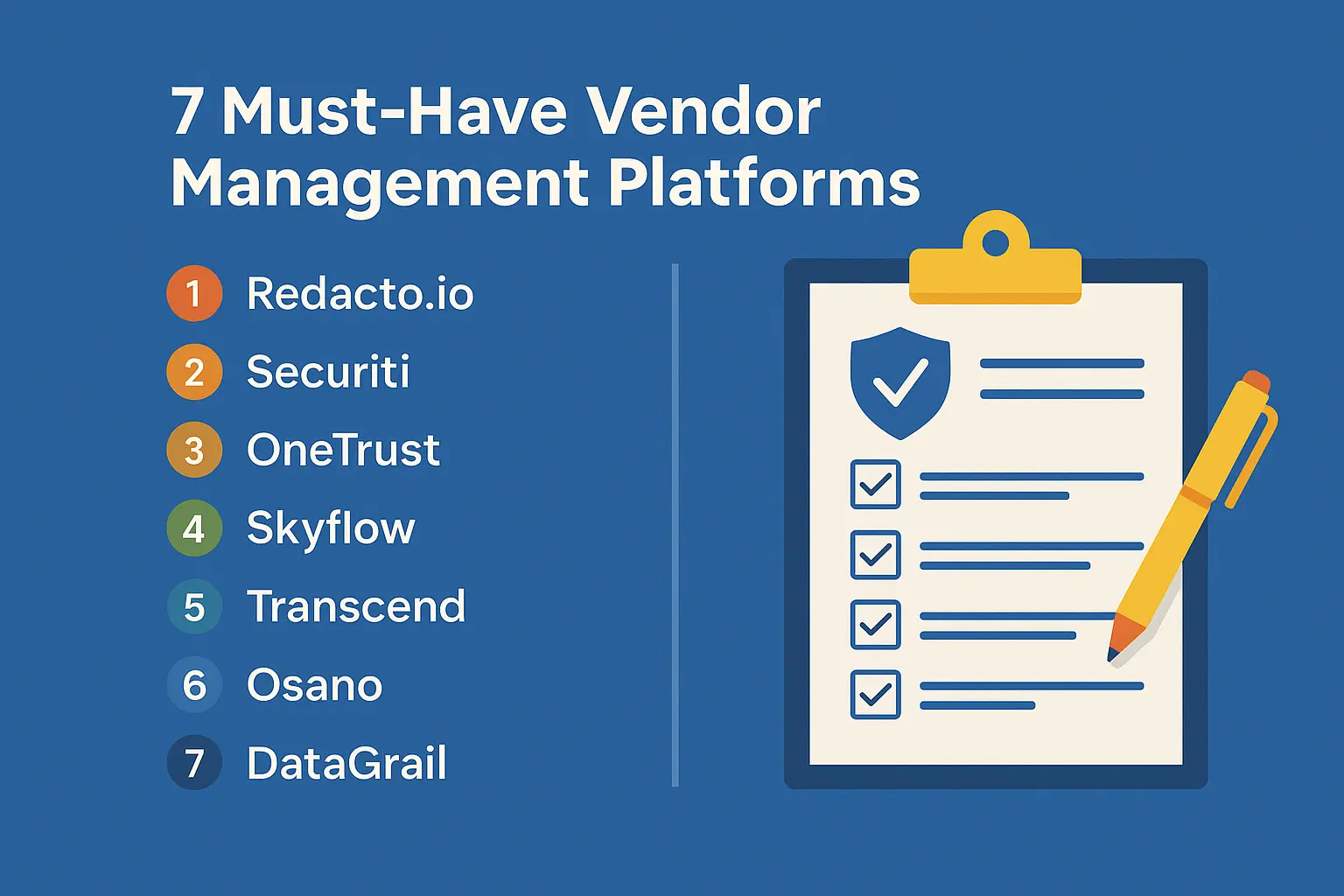Data Flow Mapping 101: Keep Your Data Safe Under DPDP Laws
Have you ever wondered how companies manage to keep track of all the personal information they work with and avoid getting in trouble? With strict rules like GDPR in Europe and DPDP in India, making mistakes can result in substantial fines or eroding customer trust. It’s a real headache to make sure everything’s safe and legal.
That’s where a cool idea called data mapping comes in. It is similar to mapping a guide so as to determine where data hides in a company system to avoid penalties.
If you’re looking for help, tools like Redacto can make navigating these privacy challenges a bit easier. Let us find out more about data mapping and the ways it assists companies.
What is Data Mapping?
Data mapping is merely the process of developing a clear image of your business data. It displays the starting and storage locations of information such as the names or emails of the customers. This process will assist you in monitoring data flow in your systems.
This process helps you track how data moves through your systems. It ensures no important information is lost or handled incorrectly.
It is very important to know about mapping data to comply with privacy regulations such as GDPR and DPDP. Under these laws, businesses must be aware of where personal data is exactly located in order to keep them safe and continue to adhere with compliance.
Why Does Data Mapping Matter for Your Business?
Data mapping is quite important to a business that deals with personal information. In the absence of data mapping, you may be unaware of the location where sensitive information such as customer email addresses or customers address is saved and this may cause serious issues. Regulations such as GDPR in Europe, DPDP in India, and CCPA in California contain strict regulations regarding the protection of data. Failing to locate or obtain it will result in huge fines, and legal implications and even lead to customer mistrust.
A clear data map will keep you on track of these risks. It allows you to respond to customer or regulator data requests promptly, which is one of the main requirements of GDPR and DPDP.
- A proper data map ensures compliance with privacy laws.
- It helps spot weak spots in data security.
- Data mapping builds confidence with privacy-conscious clients.
Therefore, it is a wise idea to spend some time on data mapping. It is not only about the penalty avoidance under regulations, such as GDPR or DPDP but about executing a safer and more trustworthy business.
Data Mapping Techniques

Data mapping is an important process regarding data management as it helps to keep data properly organized and adhere to the relevant laws, such as GDPR and DPDP. Various methods assist the companies in developing a transparent data map to monitor the origin, flow, and destination of the information. We will take a closer look at some of the most important data mapping techniques in a user-friendly language that will give you an idea about the functioning of each technique in terms of privacy and security.
1. Manual Data Mapping
Manual data mapping describes the process of following data manually, usually in the forms of spreadsheets or documents. You specify the source of data such as the name of customers, storage of the data, and the party who utilizes the data. This approach is applicable to small companies that do not have much information.
It costs little and provides complete control, yet it is slow and error-prone. With an increasing amount of data, it becomes difficult to keep a data map up-to-date, particularly when handling laws such as GDPR or DPDP.
2. Automated Data Mapping
Automated data mapping involves use of software to scan and track data between systems. Applications or databases are examined with tools that create a data map where the information such as addresses or emails resides. It is quick and reduces errors.
Such an approach is best used to support more significant businesses that have much data. It assists you in complying with stringent requirements out of GDPR, DPDP, and CCPA guidelines by ensuring that your mapping data is accurate and up-to-date with minimal effort.
3. Semi-Automated Data Mapping
Semi-automated data mapping combines manual work and software assistance. To locate data, machine tools carry the bulk of the work, though human beings subsequently assess and update the map of the data. It is a tradeoff between speed and control.
This suits companies that need a little control and save time. It helps to adhere to regulations such as GDPR, DPDP, etc. as you will no longer depend on manual efforts as much with the process of your mapping data.
Data Mapping Process
Establishing a transparent data map is critical to ensure that the business can handle information and abide by privacy legislation such as GDPR and DPDP. Data mapping relies on several steps to trace data flow and data sources. To develop your mapping data strategy, we have described these steps in an easy way below.
- Identify Data Sources: Start by finding where data enters your business, like websites, forms, or apps. This helps you see the starting points for data mapping.
- Catalog Data Types: List what kind of data you have, such as names or emails. Knowing this is crucial for mapping data under laws like GDPR.
- Track Data Storage: Check where data is kept, like servers or cloud systems. A good data map shows these spots to stay compliant with DPDP.
- Map Data Flows: See how data moves between systems or teams. Data flow mapping reveals the path to protect info as per GDPR rules.
- Document and Update: Write down your data map and keep it current as things change. Regular updates ensure compliance with laws like CCPA and DPDP.
Best Practices for Data Mapping
Getting data mapping right is key for businesses to manage information safely and meet privacy laws like GDPR and DPDP. Following best practices ensures your data map is accurate and useful. Below, we share simple tips for effective mapping data to help protect your business and stay compliant with regulations.
- Start with Clear Goals: Decide why you’re doing data mapping, like meeting GDPR rules. Having a purpose keeps your efforts focused and relevant to compliance needs.
- Involve All Teams: Get input from IT, legal, and other departments. Their insights make your data map complete, ensuring nothing is missed for DPDP requirements.
- Use Automation Tools: Rely on software for mapping data to save time and reduce errors. Automated tools help track data flows accurately for laws like CCPA.
- Keep Data Secure: Protect your data map with strong access controls. This prevents leaks of sensitive info, a must under GDPR and DPDP privacy rules.
- Review Regularly: Update your data map often to reflect new systems or data. Staying current is vital to avoid penalties under laws like GDPR or DPDP.
Tools for Data Mapping
Data mapping can be tricky without the right help, but tools make it easier to track and manage information. These tools scan systems to create a clear data map, ensuring you meet privacy laws like GDPR and DPDP. They save time and reduce mistakes.
One such tool is Redacto.io’s Data Discovery. It uses AI to automatically build data maps by finding where data like customer details lives and how it flows across your business.
This helps businesses stay compliant with GDPR, DPDP, and CCPA by keeping mapping data accurate. Redacto.io cuts down manual work, so you can focus on protecting data and avoiding fines under strict laws.
Conclusion
Data mapping is a must for businesses to keep data safe and follow laws like GDPR and DPDP. Creating a clear data map helps avoid risks and builds trust. Start your mapping data journey now to stay compliant and protect your business from penalties under strict privacy regulations.
FAQs
1. What is data mapping?
Data mapping is creating a picture of where your business data starts, moves, and is stored. It’s key for following privacy laws like GDPR.
2. Why is data mapping important?
Data mapping helps track data to avoid fines under laws like DPDP. It ensures you know where info is to keep it safe.
3. How does data flow mapping work?
Data flow mapping shows how data moves in systems. It’s part of data mapping to spot risks and meet GDPR or DPDP rules.
4. What tools help with data mapping?
Tools like Redacto.io’s Data Discovery automate mapping data. They build accurate data maps to stay compliant with laws like CCPA easily.
5. How often should I update my data map?
Update your data map regularly as data changes. This keeps you compliant with GDPR and DPDP, avoiding issues from outdated info.




%20Redacto%20logo_New.png)



.jpg)

.jpg)
.png)
